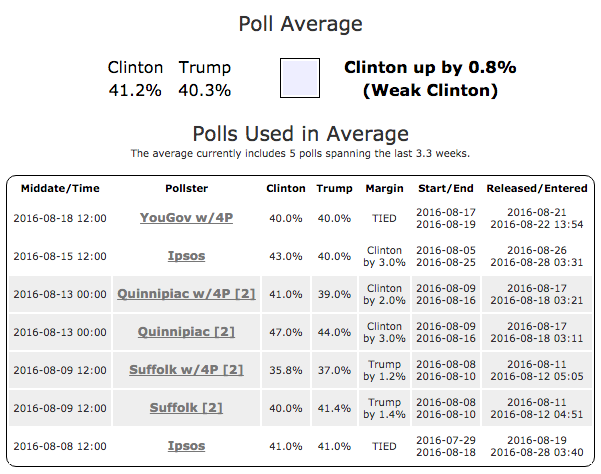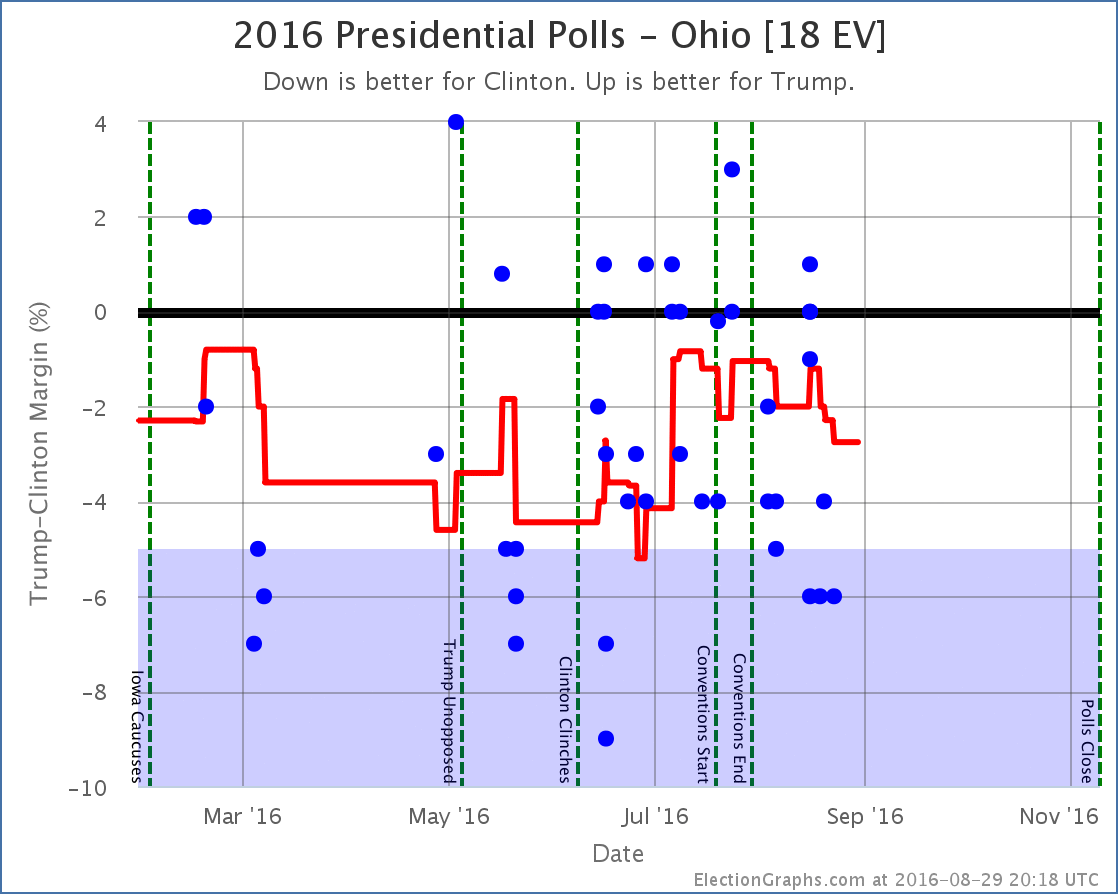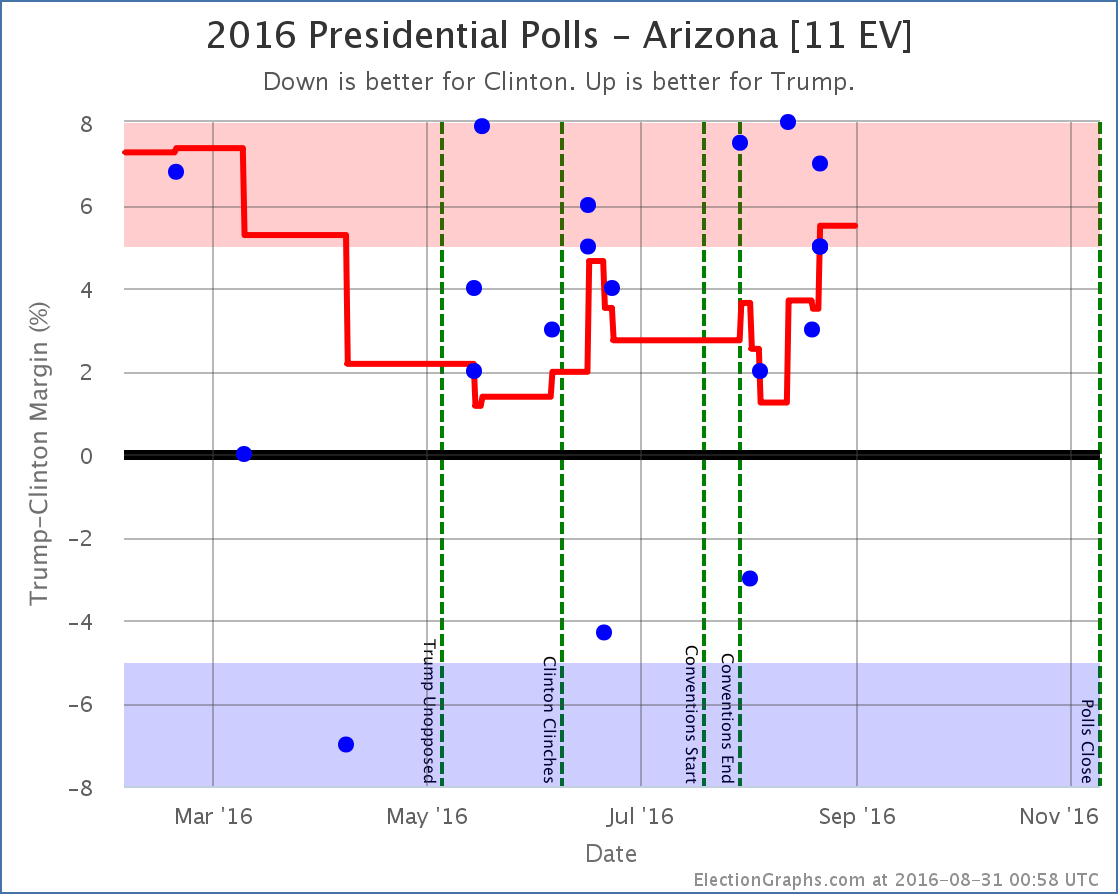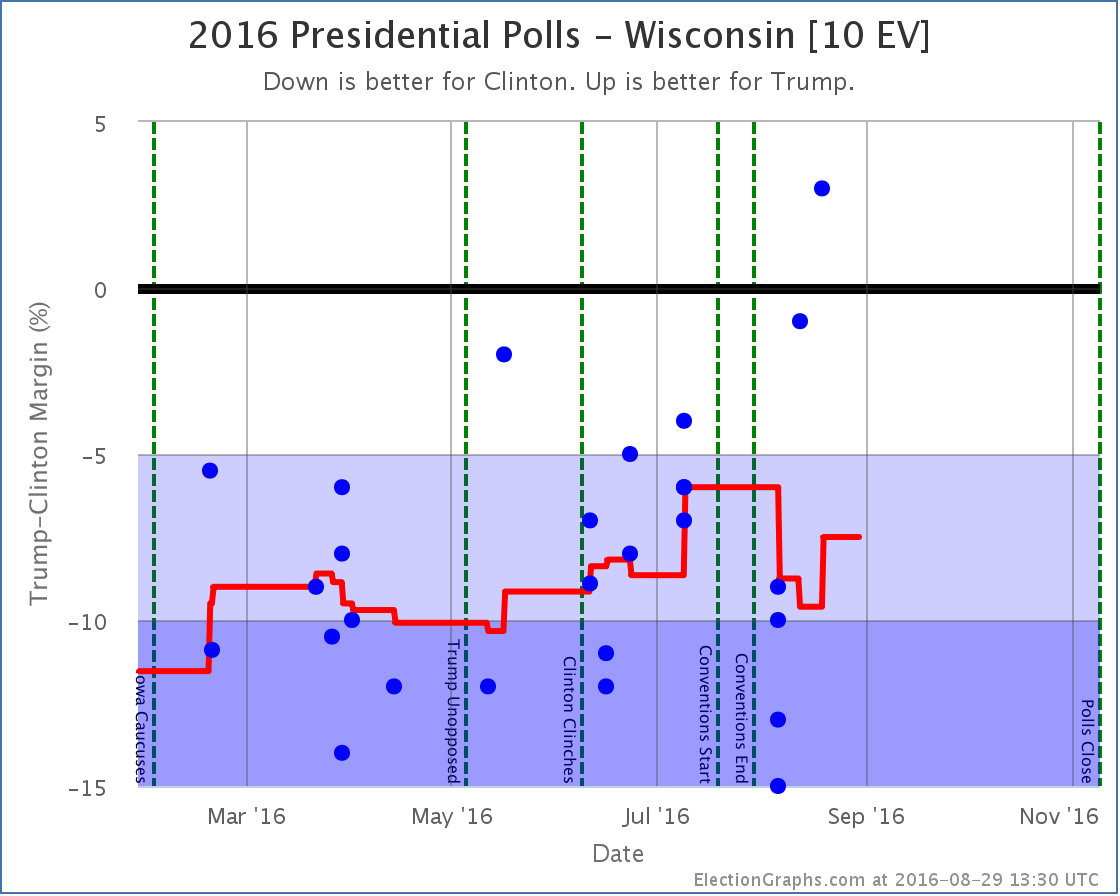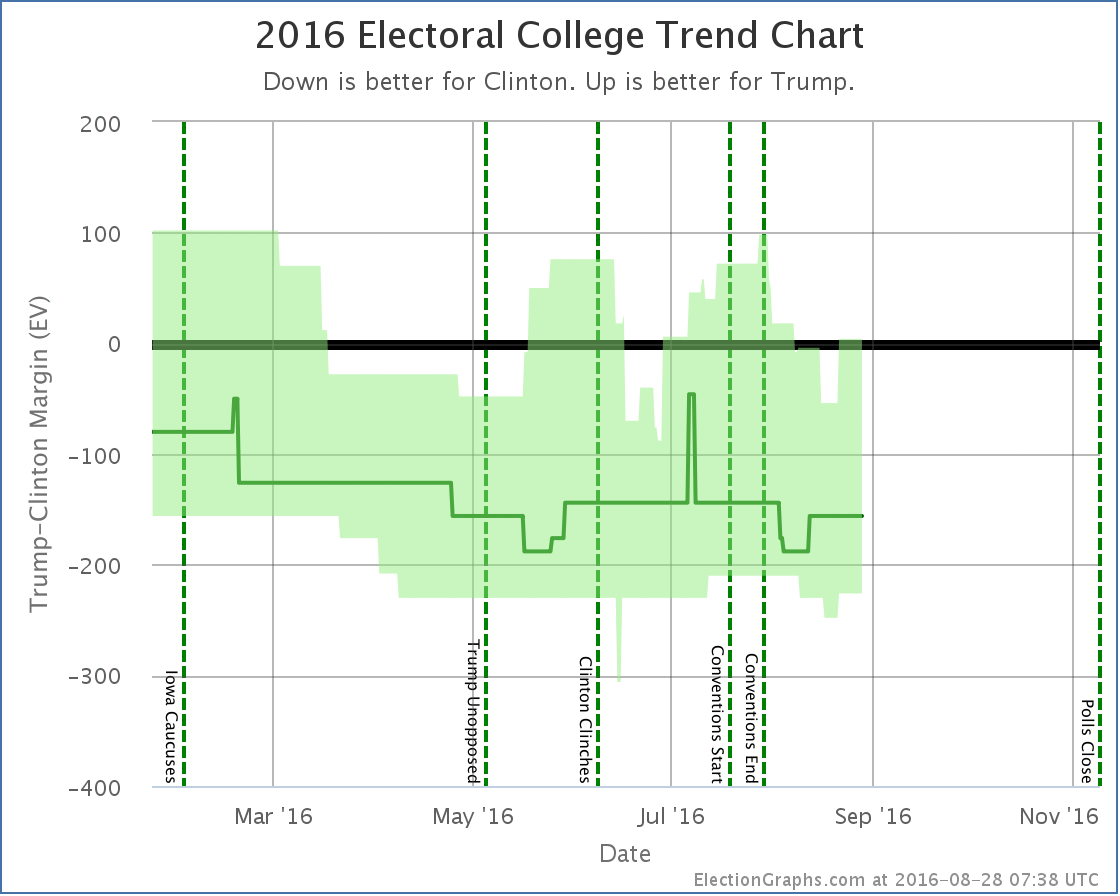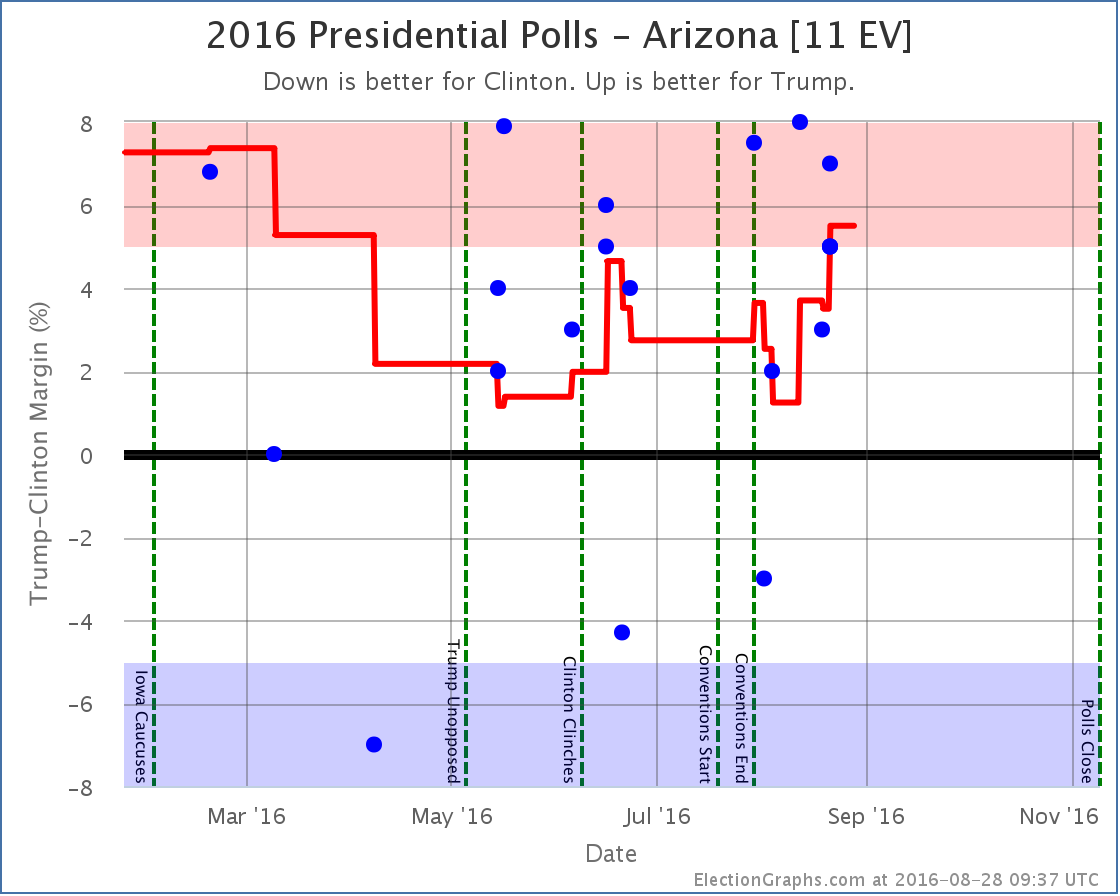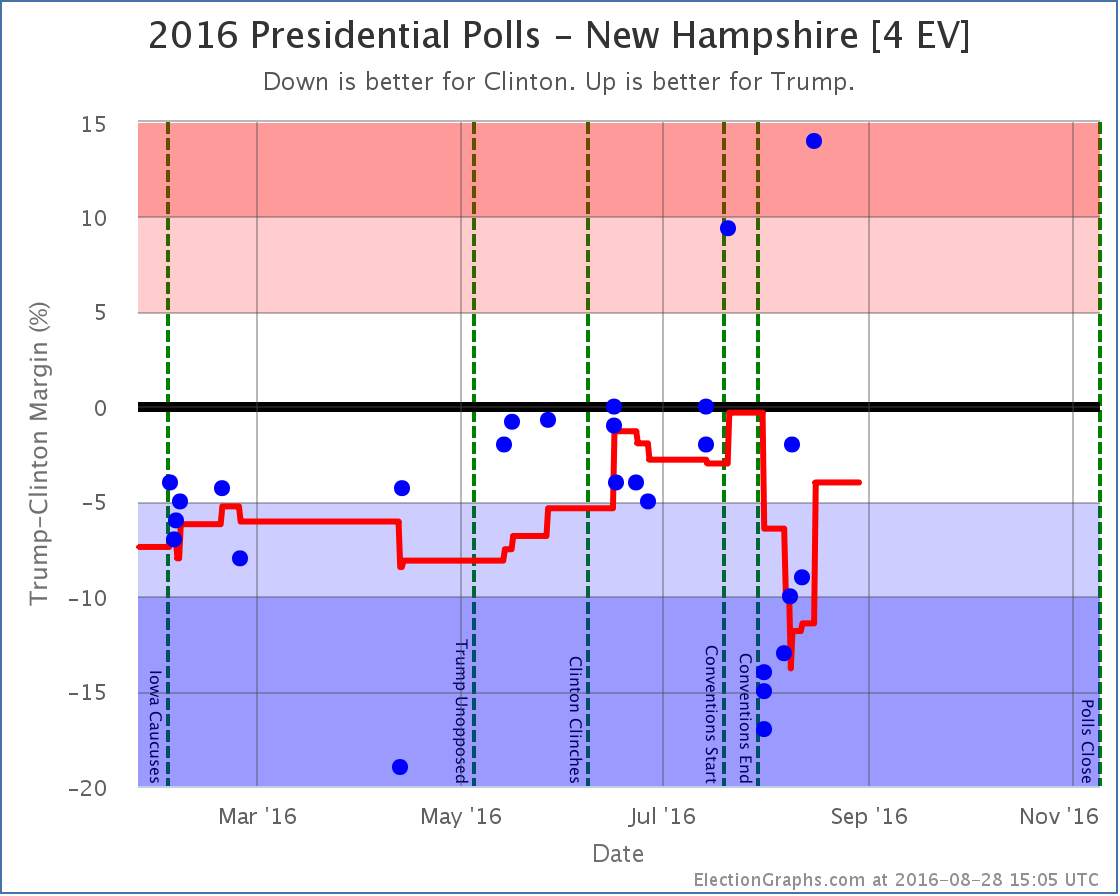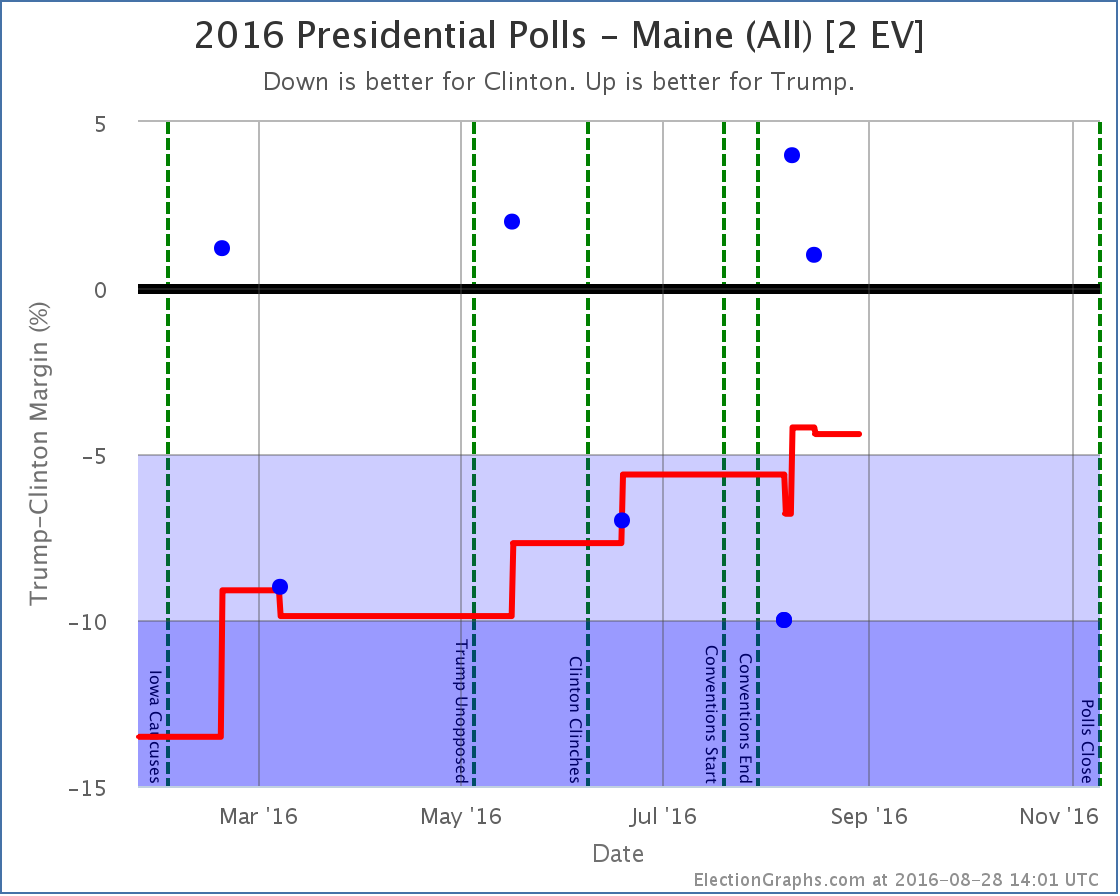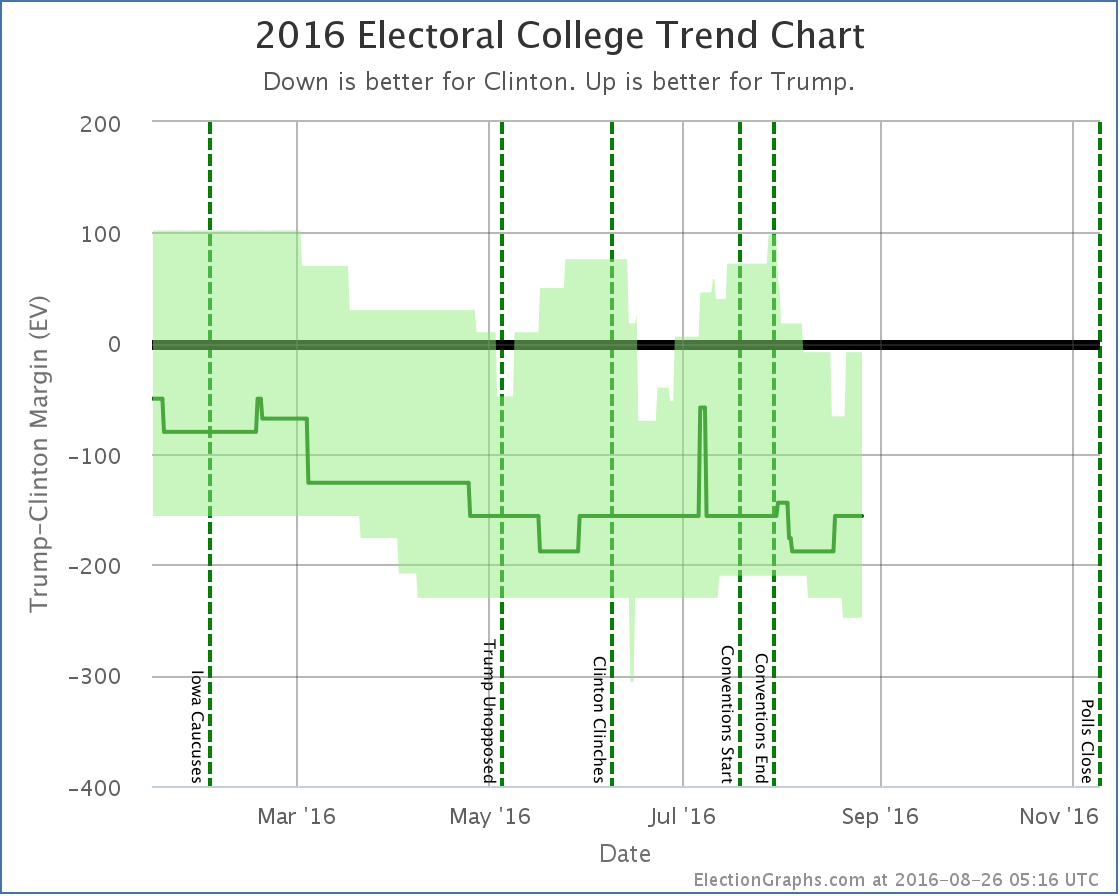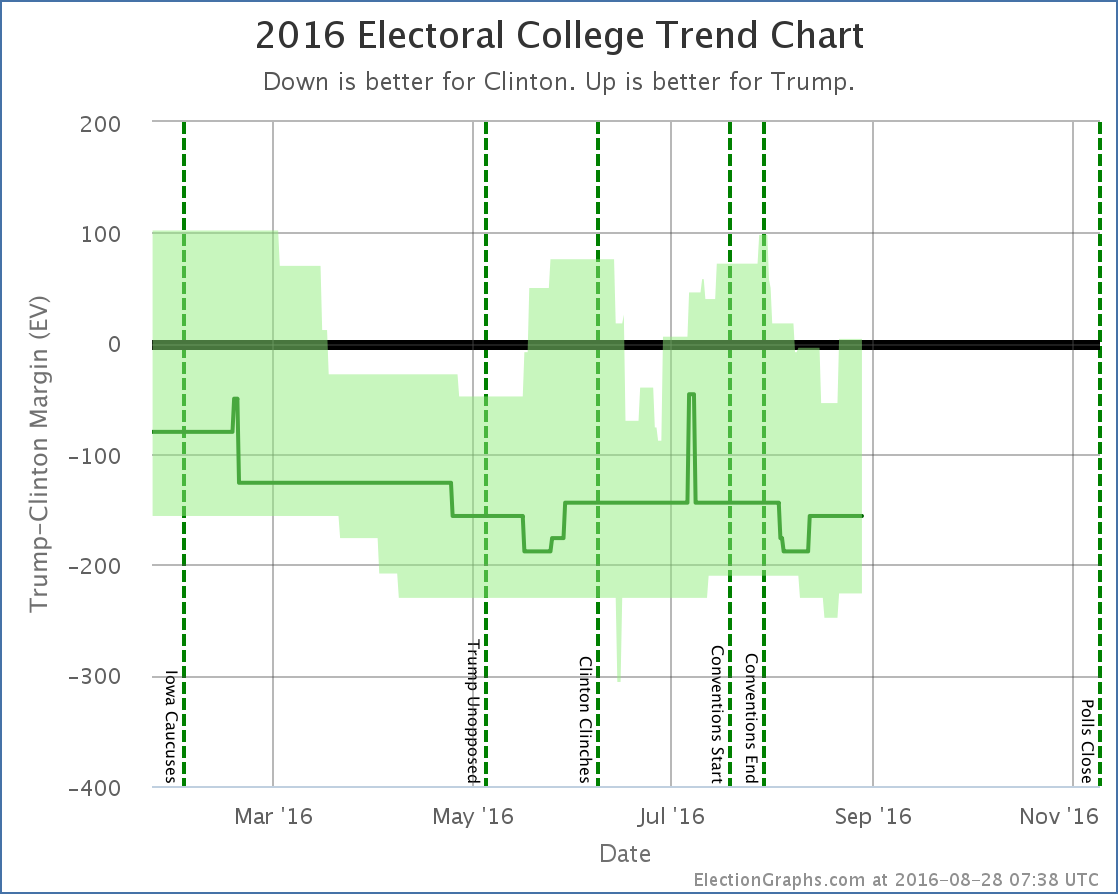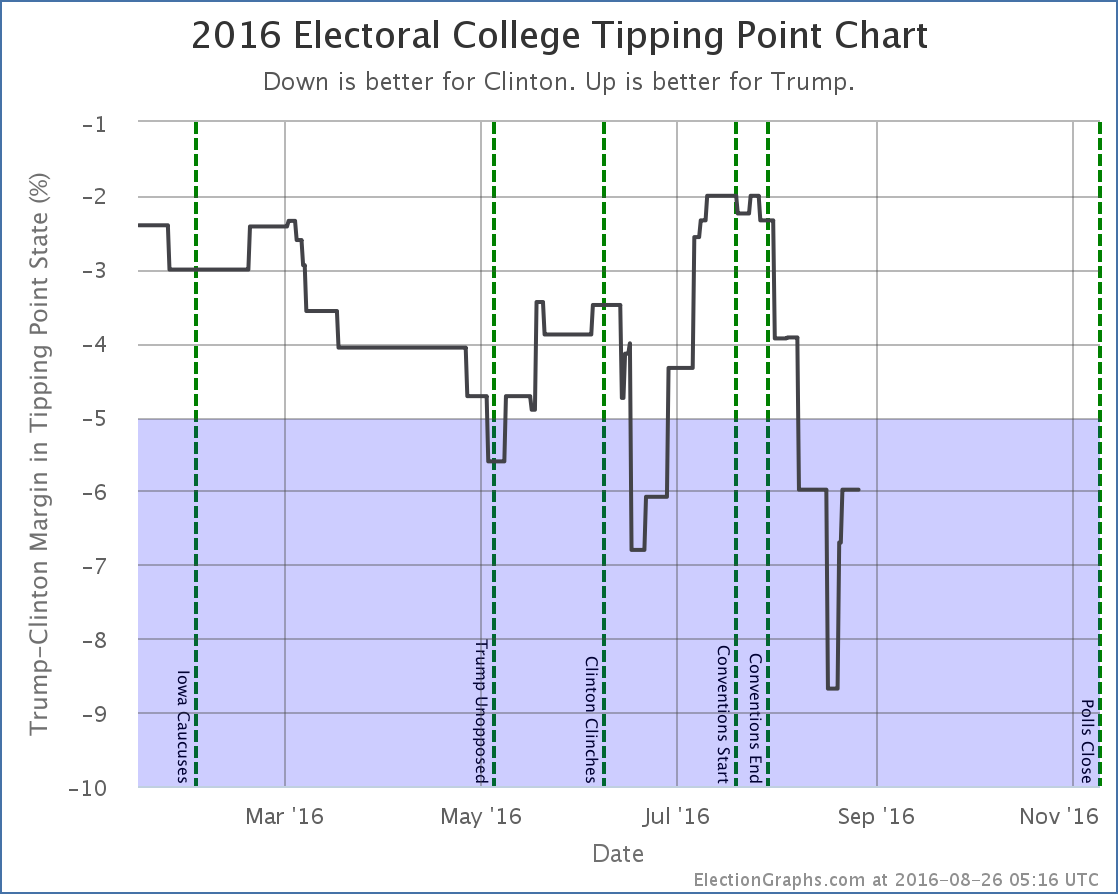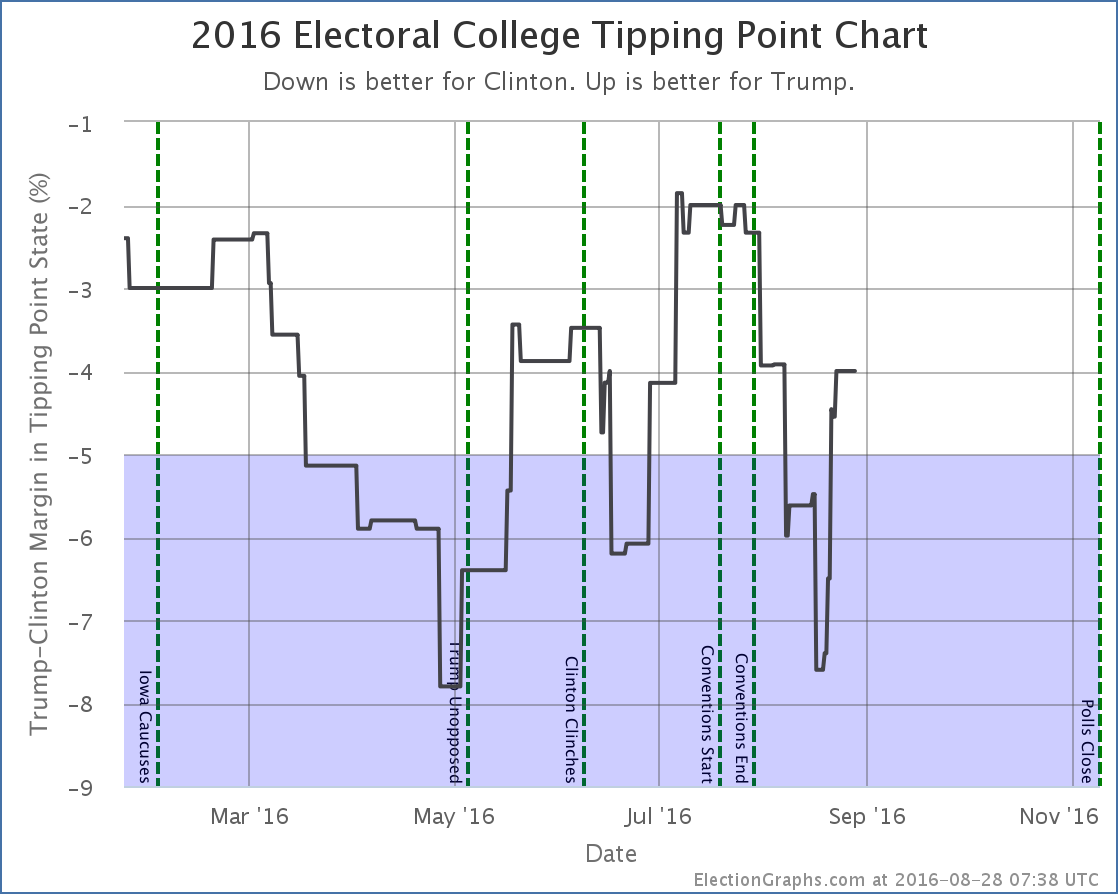States with new poll data added since the last update: None, this isn’t that kind of update. Instead of new data, there is a change to how averages are calculated.
TL;DR
I changed the details on the way the poll averages are calculated to prevent pollsters who release multiple results on the same poll from having an outsized influence on the average. This changed the overall national summary as follows:
- Trump’s best case improved from winning by 4 electoral votes to winning by 24 electoral votes, since Wisconsin now looks like a close state that Trump has a shot in.
- The tipping point moved from Clinton by 4.0% in NH to Clinton by 4.4% in OH as the average moved a little toward Clinton in Ohio.
- Clinton’s best case improved from winning by 226 electoral votes to winning by 248 electoral votes since Arizona once again looks like a close state that Clinton has a shot in.
The changes also modified the shape of the historical graphs a bit. Details follow for those who are interested.
The Problem
The issue is that sometimes pollsters release multiple results from a single underlying poll sample. For instance they will give results when only the two major party candidates are mentioned, but also results if respondents are also asked about third party candidates. Or they will release both “registered voter” and “likely voter” results. Or other variants.
In the interest of simplicity and a bias toward including as much data as possible, when this happened, I included all of the different results a pollster released, and just threw them into the average as if they were completely independent results.
But of course they are not.
Since the same underlying sample was used, the results are often much more similar to each other than separate polls tend to be. So I was essentially giving extra weight to pollsters who tended to release multiple results. This has the effect of making the averages more volatile than they would be otherwise, since effectively I’d be really using fewer data sources to determine the average rather than the normal minimum of five.
In some cases pollsters were even starting to release four separate results, which since I generally use five poll averages could mean that four of the five polls in the average came from the same sample. In other cases almost every poll in a state included multiple results. It was clear this was having an impact and I would probably have to change something.
The Solution
I considered a number of possible ways to address this over the last couple months. Over the last few weeks I have also been engaging with a number of Election Graphs readers about this issue and the possible solutions via the comments on this site, email, and even by phone in one case. You can see some of this discussion in the post here.
In the end I selected a solution where I weight these types of results so that if a poll includes two different variants, each of those results count as half a poll, both for the averaging itself and for determining which polls to include in the average. If the poll released three variants, each would count as a third of a poll, if they release four, each would count as a fourth, etc.
Using Iowa as an example:
Quinnipiac and Suffolk released two results each, one with just the two major candidates, one with Johnson and Stein also added into the question. The polls in question get a grey background to highlight that they are being weighted. The more variants a poll has, the darker the grey. The number in [] indicates how many variants were in that poll. The summary still says this is an average of five polls, as each of the Quinnipiac and Suffolk variants count as half a poll in the averaging.
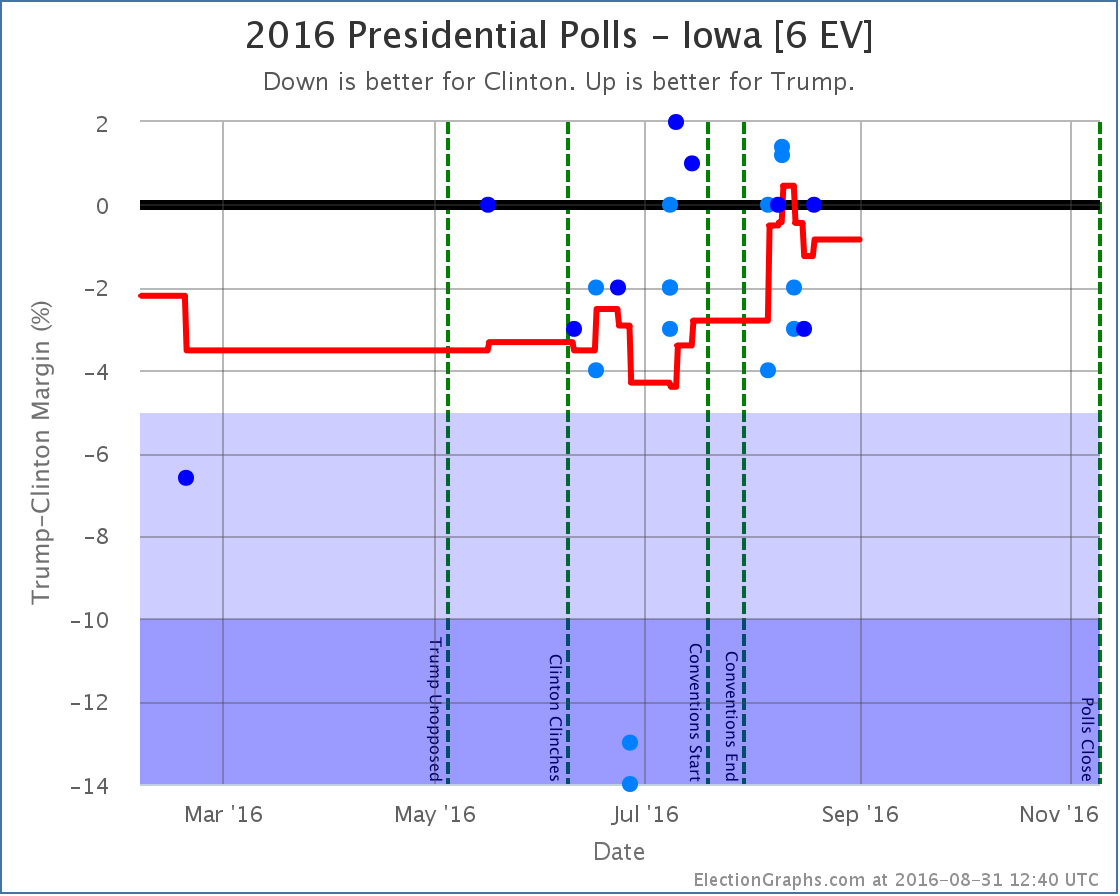
The graphs also change the color of data points that are weighted in this way. The lighter the color of blue, the less weight to the data point. This makes it as clear as possible when viewing these charts that some of the data points count more than others.
The Impact
Obviously any change to the way in which averages are constructed will cause those averages to be different. There are any number of choices made on this site that would have similar impact. As an example, the choice of five poll averages rather than using six polls or four polls. The general picture wouldn’t be expected to change much, but some details will.
In this case there were three states that changed in ways that caused an adjustment to the national summary. For each of these I’ll show an animation of the state chart before and after the change. The frame of the animation that includes lighter blue dots is the new version of the chart.
Ohio [18 EV]
Ohio moved from a 2.8% Clinton lead to a 4.4% Clinton lead, a 1.6% move toward Clinton. Ohio is classified as “Weak Clinton” either way, but this changed the tipping point. This also eliminated a brief period earlier in the year when Ohio had been “Strong Clinton”.
Arizona [11 EV]
Arizona moved from a 5.5% Trump lead to a 3.1% Trump lead, a 2.4% move toward Clinton. This undid the recent Arizona move from “Weak Trump” to “Strong Trump” and improved Clinton’s best case from winning by 226 electoral votes to winning by 248 electoral votes since Arizona now once again looks like a close state that Clinton has a shot in.
Wisconsin [10 EV]
Wisconsin moves from a 7.5% Clinton lead to a 4.8% Clinton lead, a 2.7% move toward Trump. This moves Wisconsin from “Strong Clinton” to “Weak Clinton”, putting the state in play for Trump and improving his best case from winning by 4 electoral votes to winning by 24 electoral votes.
Other states
A number of other states were impacted by the change in how averages are constructed, but did not do so in ways that in turn changed the national summary. These were:
- California [55 EV]: Clinton 28.6% -> Clinton 28.3% (0.3% toward Trump)
- Texas [38 EV]: Trump 10.0% -> Trump 10.3% (0.3% toward Trump)
- Florida [29 EV]: Clinton 1.3% -> Clinton 2.0% (0.7% toward Clinton)
- New York [29 EV]: Clinton 21.7% -> Clinton 19.8% (1.9% toward Trump)
- Pennsylvania [20 EV]: Clinton 7.3% -> Clinton 7.1% (0.2% toward Trump)
- Georgia [16 EV]: Trump 0.8% -> Trump 0.8% (Historical graph change only)
- Michigan [16 EV]: Clinton 5.4% -> Clinton 5.5% (0.1% toward Clinton)
- North Carolina [15 EV]: Clinton 1.2% -> Clinton 1.8% (0.6% toward Clinton)
- New Jersey [14 EV]: Clinton 15.0% -> Clinton 12.7% (2.3% toward Trump)
- Virginia [13 EV]: Clinton 10.6% -> Clinton 11.2% (0.6% toward Clinton)
- Washington [12 EV]: Clinton 16.0% -> Clinton 14.4% (1.6% toward Trump)
- Massachusetts [11 EV]: Clinton 17.7% -> Clinton 18.8% (1.1% toward Clinton)
- Colorado [9 EV]: Clinton 8.3% -> Clinton 8.4% (0.1% toward Clinton)
- South Carolina [9 EV]: Trump 2.0% -> Trump 3.2% (1.2% toward Trump)
- Connecticut [7 EV]: Clinton 7.6% -> Clinton 7.4% (0.2% toward Trump)
- Iowa [6 EV]: Clinton 0.9% -> Clinton 0.8% (0.1% toward Trump)
- Mississippi [6 EV]: Trump 15.2% -> Trump 13.0% (2.2% toward Clinton)
- Nevada [6 EV]: Clinton 1.8% -> Clinton 1.8% (Historical graph change only)
- Utah [6 EV: Trump 12.6% -> Trump 10.9% (1.7% toward Clinton)
- New Hampshire [4 EV]: Clinton 4.0% -> Clinton +4.0% (Historical graph change only)
- Alaska [3 EV]: Trump 10.8% -> Trump 12.3% (1.5% toward Trump)
- Maine-All [2 EV]: Clinton 4.4% -> Clinton 2.0% (2.4% toward Trump)
If anybody is interested in the before/after animations for any of these states, ask me. It would have been too much to include them all here in this post.
National View
The changes in all these states of course changed the two national graphs as well. The versions with data a little further to the right are the “after” frames.
The overall shape of the electoral college trend chart is similar before and after, although Trump’s best case is now a bit better off in the time between Clinton clinching and the start of the conventions. The brief July spike toward Trump in the expected case also disappears. And of course both candidate’s best cases improve a bit at the current time.
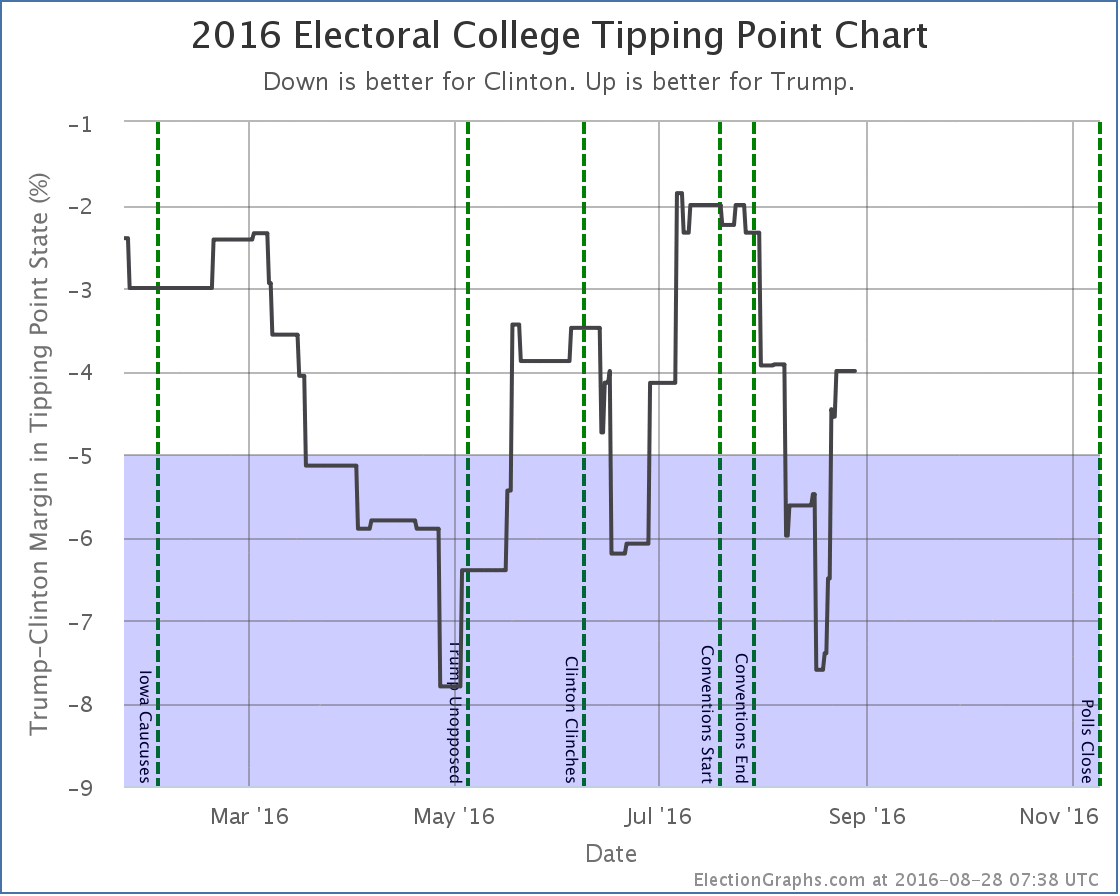
The main impact on the tipping point chart seems to have been to mute the extremes. The high in July wasn’t quite as high, the low in August wasn’t quite as low.
The map view would have changed too of course, but unfortunately I did not save off a “before” version of the map, so couldn’t produce a nice animation. The graphs above tell the story nicely though I think.
In the end, while I think this correction was important to make, it doesn’t significantly change much in the national view, or the narrative of this campaign. Trump has been behind the entire race. At times he has been able to make it a bit closer, but then seems to fall back again. Electoral college wise Clinton seems to be bouncing between winning by 144 electoral votes and winning by 188 electoral votes in the “expected case”. The range between the best cases is wider and a bit more volatile, and usually includes a narrow Trump win as a possibility, but often does not. On the tipping point, Trump’s ceiling seems to be about a 2.5% Clinton lead, and his floor seems to be about an 8% Clinton lead.
All in all, with these bookkeeping changes in place to stop giving extra weight to some pollsters, the race looks even more stable than it did before. Yes, things bounce around a bit, but fundamentally we’re in basically the same place we have been since mid-May with only minor changes.
We can and will continue to talk about the ups and downs day to day and week to week, but absent something really big happening, this race looks like it doesn’t want to budge much.
69.1 days for that to change.
Note: This post is an update based on the data on ElectionGraphs.com. Election Graphs tracks both a poll based estimate of the Electoral College and a numbers based look at the Delegate Races. All of the charts and graphs seen in this post are from that site. Additional graphs, charts and raw data can be found there. Follow @ElectionGraphs on Twitter or like Election Graphs on Facebook to see announcements of updates or to join the conversation. For those interested in individual general election poll updates, follow @ElecCollPolls on Twitter for all the polls as they are added. If you find the information in these posts interesting or useful, please consider visiting the tip jar.
